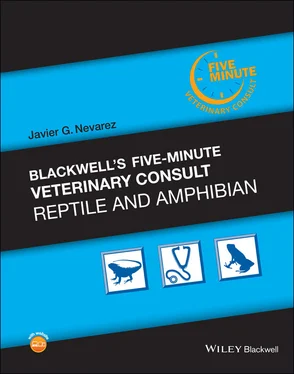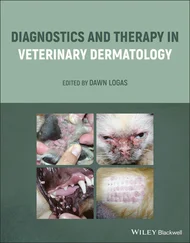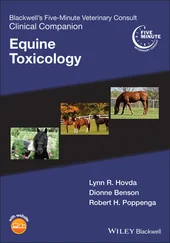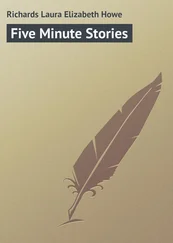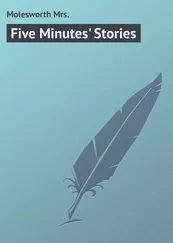Javier G. Nevarez - Blackwell's Five-Minute Veterinary Consult - Reptile and Amphibian
Здесь есть возможность читать онлайн «Javier G. Nevarez - Blackwell's Five-Minute Veterinary Consult - Reptile and Amphibian» — ознакомительный отрывок электронной книги совершенно бесплатно, а после прочтения отрывка купить полную версию. В некоторых случаях можно слушать аудио, скачать через торрент в формате fb2 и присутствует краткое содержание. Жанр: unrecognised, на английском языке. Описание произведения, (предисловие) а так же отзывы посетителей доступны на портале библиотеки ЛибКат.
- Название:Blackwell's Five-Minute Veterinary Consult: Reptile and Amphibian
- Автор:
- Жанр:
- Год:неизвестен
- ISBN:нет данных
- Рейтинг книги:4 / 5. Голосов: 1
-
Избранное:Добавить в избранное
- Отзывы:
-
Ваша оценка:
- 80
- 1
- 2
- 3
- 4
- 5
Blackwell's Five-Minute Veterinary Consult: Reptile and Amphibian: краткое содержание, описание и аннотация
Предлагаем к чтению аннотацию, описание, краткое содержание или предисловие (зависит от того, что написал сам автор книги «Blackwell's Five-Minute Veterinary Consult: Reptile and Amphibian»). Если вы не нашли необходимую информацию о книге — напишите в комментариях, мы постараемся отыскать её.
STAY UP TO DATE ON THE BEST PRACTICES FOR TREATING COMMON DISEASES IN REPTILES AND AMPHIBIANS Blackwell’s Five-Minute Veterinary Consult: Reptile and Amphibian
Blackwell’s Five-Minute Veterinary Consult: Reptile and Amphibian
Blackwell's Five-Minute Veterinary Consult: Reptile and Amphibian — читать онлайн ознакомительный отрывок
Ниже представлен текст книги, разбитый по страницам. Система сохранения места последней прочитанной страницы, позволяет с удобством читать онлайн бесплатно книгу «Blackwell's Five-Minute Veterinary Consult: Reptile and Amphibian», без необходимости каждый раз заново искать на чём Вы остановились. Поставьте закладку, и сможете в любой момент перейти на страницу, на которой закончили чтение.
Интервал:
Закладка:
Unlike mammals, the bone epiphyses do not close in chelonians, snakes, and crocodilians. Epiphyses close later in life in lizards. Reptiles have intervertebral bodies rather than disks. These intervertebral bodies are softer and form convexities in the anterior or posterior aspect to allow for additional flexibility and decreased pressure on the spinal cord. This arrangement allows reptiles the ability to tolerate and recover from spinal trauma better than mammals.
Reptile orders are classified based on the presence or absence of fenestrae in the temporal region of the skull. Anapsids lack temporal openings (chelonians). Diapsids have two openings in the temporal region behind the orbit, one superior (dorsal) and one inferior (tuataras and crocodilians). Squamates are modified diapsids, with lizards having only a dorsal opening while snakes have lost the upper temporal arch between the two openings. The quadrate bone articulates between the maxilla and mandible allowing increased movement of the skull, including the maxilla, a feature critical for some reptile species. Streptostyly is the ability of the quadrate bone to move back and forth in snakes due to their modified diapsid skull. Lizards and crocodilians have powerful snapping jaws due to the adductor muscles that arise from the temporal fossae and insert at right angles to open the jaw.
The vertebral column of reptiles can be divided into three sections: presacral (24 in lizards, 18 in chelonians, over 200 in snakes), sacral, and caudal. The atlas and axis are more rigidly connected than in mammals, so primary neck movement is between the single occipital condyle and the vertebral column. The number of cervical vertebrae varies across species, with crocodilians and varanids having nine, chelonians, tuataras, and most lizards eight, and chameleons three to five. There is no subarachnoid space but a subdural space between the leptomeninges and the dura mater is present.
CARDIOVASCULAR
The heart of crocodilians has four chambers (two atria and two ventricles) while that of all other reptile species has three chambers (two atria and one ventricle). The ventricle of non‐crocodilian reptile hearts is divided into three chambers separated by incomplete muscular ridges. The cavum venosum receives blood from the right atrium dorsally and the paired aortas ventrally. The cavum arteriosum receives blood from the left atrium. The cavum pulmonale opens into the pulmonary artery and is equivalent to right ventricle in mammals. The admixture of oxygenated and deoxygenated blood varies across species and is influenced by the presence of a muscular ridge separating the three areas of the ventricle. The right and left cranial vena cava and the left hepatic vein supply blood to the sinus venosus. Reptiles have two aortas, with the left aorta giving rise to the celiac, cranial mesenteric, and left gastric arteries before joining the right aorta caudal to the heart. The blood flow through a non‐crocodilian heart is outlined in Figure 1 (see web image supplementary content for section I).
RESPIRATORY SYSTEM
Nasal conchae are absent in chelonians but are present in other reptiles. Crocodilians and chelonians have complete tracheal rings, while they are incomplete in snakes and lizards. The lung anatomy is one of three basic types. Unicameral lungs are simple, single‐chambered structures found in most snakes and some lizards, including tuataras. Paucicameral or transitional lungs have some internal divisions, but these are mostly incomplete and do not split the lung into separate chambers. They also lack intrapulmonary bronchus. Most iguanids, chameleons, and agamids have paucicameral lungs. Multicameral lungs are more complex with internal divisions and multiple bronchi. These lungs can be found in varanids, helodermatids, chelonians, and crocodilians. Chelonians have an exception as they possess a single, unbranched bronchus running the entire length of the lungs, with all lung chambers opening into this single bronchus.
In snakes, the lungs transform into an air sac structure caudally near the liver. In terrestrial species, the lung air sac terminates near the gallbladder, while in some aquatic species it terminates near the cloaca. In boids and colubrids, the respiratory portion is located between the heart and the cranial pole of the liver, while in most viperids and elapids there is a respiratory portion cranial to the heart. The right lung is always larger than the left. The left lung is well developed in boids and vestigial in colubrids. Multichambered lungs are found in the snake families Anomalepididae (primitive blind snakes), Typhlopidae (blind snakes), and Acrochordidae (primitive aquatic snakes from Australia and Indonesia).
Instead of alveoli, reptiles have faveolae (deeper than they are wide) and ediculae (wider than they are deep), which are exchange chambers that have a similar function to alveoli. Both are present in the lung tissue but absent in the air sacs. Reptiles have a large lung volume but only 10–20% of the surface area when compared with mammals of similar size. Ventilation is triphasic with a cycle of expiration, inspiration, and relaxation (breath holding) that creates a constant fluctuation of oxygen concentration in the lungs. Oxygen tension and temperature have a significant role in ventilation/respiration. At higher temperatures, there is an increased demand for oxygen, which leads to an increase in tidal volume. Respiratory rate increases at low oxygen tensions and decreases at high oxygen tension.
DIGESTIVE SYSTEM
Reptilian teeth are composed of enamel, dentine, and cement, but lack a periodontal membrane. There are three types of dentition. Acrodont teeth attach to the surface of the bone and are not replaced. These are present in many lizards (bearded dragons, chameleons, water dragons). Pleurodont teeth attach to the labial aspect of the bone and are replaced. Pleurodont teeth can be found in snakes and iguanid lizards. Thecodont teeth attach via deep bony sockets and are continuously replaced, often throughout life. Thecodont teeth are present in crocodilians and some consider snake teeth as modified thecodonts.
Snakes and lizards hatched out of eggs possess an egg tooth, a modified premaxillary tooth to help break through the egg and its membranes. Chelonians and crocodilians have an egg caruncle—a horny tissue in that serves the function of the egg tooth.
Snake dentition is further classified based on presence or absence of fangs. Aglyphous snakes lack fangs (boids). Opisthoglyphous species are rear fanged. Some Colubridae, have modified parotid glands (hognose and boomslangs). Solenoglyphous species (Viperidae, i.e., copperheads, pit vipers, etc.) have rotating front fangs and venom glands behind the eyes. Proteroglyphous snakes (Elapidae, i.e., cobras, sea snakes) have fixed front fangs and venom glands behind the eyes.
Oral secretory glands (palatine, sublingual, mandibular) are present in many species for lubrication of prey items. In some snakes, these are modified into venom glands like the Duvernoy’s gland in colubrids. Duvernoy’s glands are posterior to the eye and some think they are analogous to venom glands in vipers and elapids while others consider them to be distinct glands. Helodermatids (Gila monsters and beaded lizards) have labial venom glands in the mandible, while snakes have maxillary venom glands.
Gastroliths may be seen radiographically and are thought to be functionally ingested only in crocodilians, with other species having accidental ingestion. Insectivorous species are thought to secrete chitinase by the stomach and pancreas to help digestion of the exoskeleton of insects.
As in birds, the cloaca is composed of the coprodeum, urodeum, and proctodeum. The colon empties into the coprodeum, while the genital and urinary openings enter the urodeum. The proctodeum is the most caudal common chamber, which receives feces and urine before an evacuation occurs.
Читать дальшеИнтервал:
Закладка:
Похожие книги на «Blackwell's Five-Minute Veterinary Consult: Reptile and Amphibian»
Представляем Вашему вниманию похожие книги на «Blackwell's Five-Minute Veterinary Consult: Reptile and Amphibian» списком для выбора. Мы отобрали схожую по названию и смыслу литературу в надежде предоставить читателям больше вариантов отыскать новые, интересные, ещё непрочитанные произведения.
Обсуждение, отзывы о книге «Blackwell's Five-Minute Veterinary Consult: Reptile and Amphibian» и просто собственные мнения читателей. Оставьте ваши комментарии, напишите, что Вы думаете о произведении, его смысле или главных героях. Укажите что конкретно понравилось, а что нет, и почему Вы так считаете.
